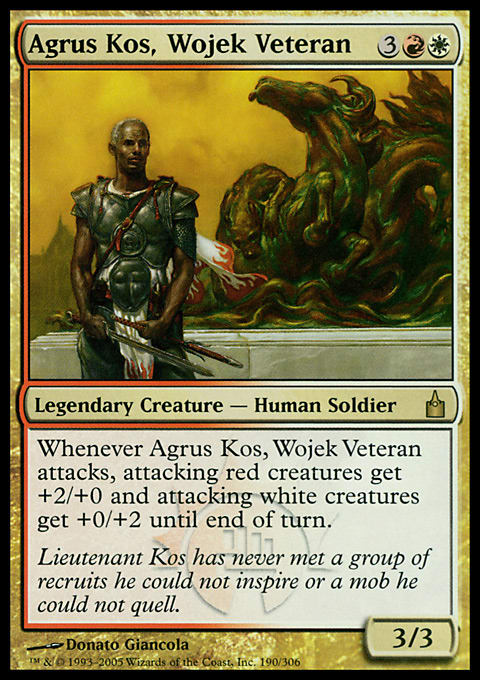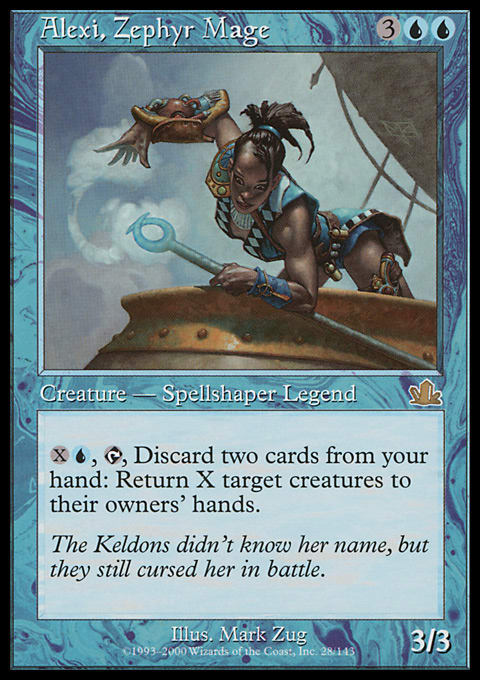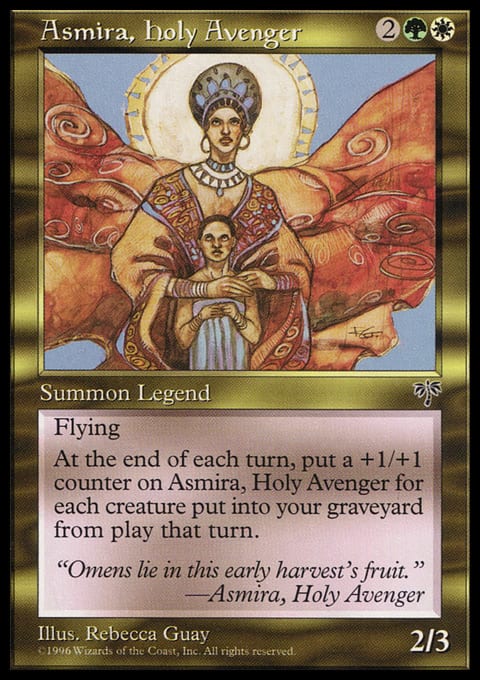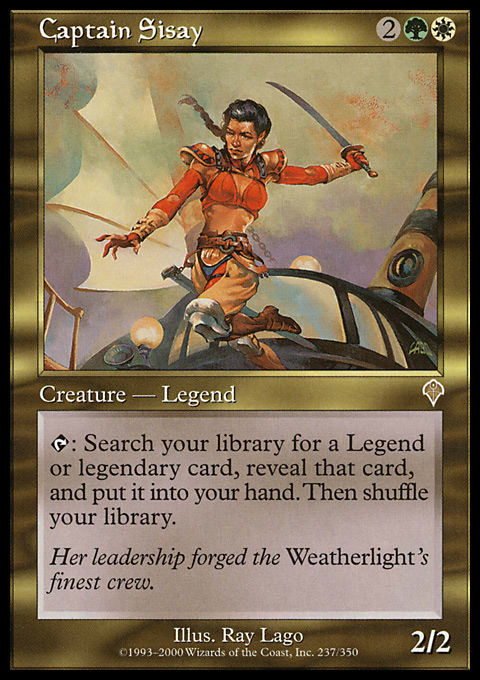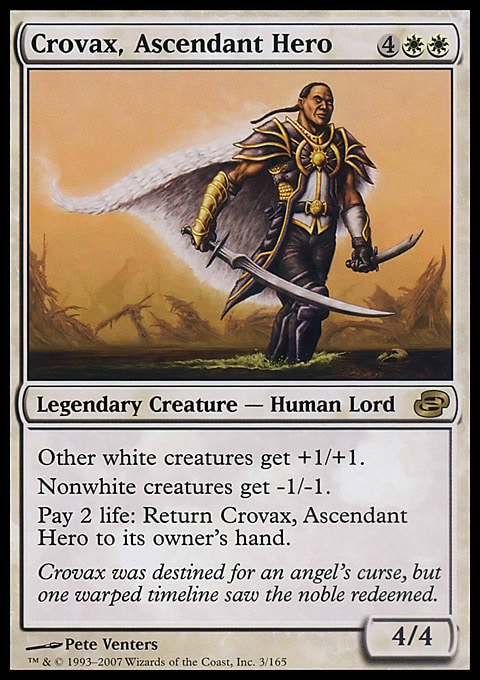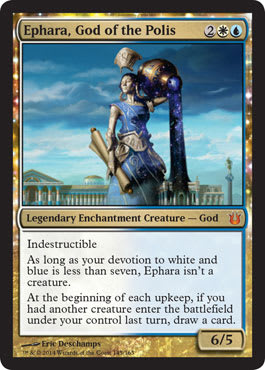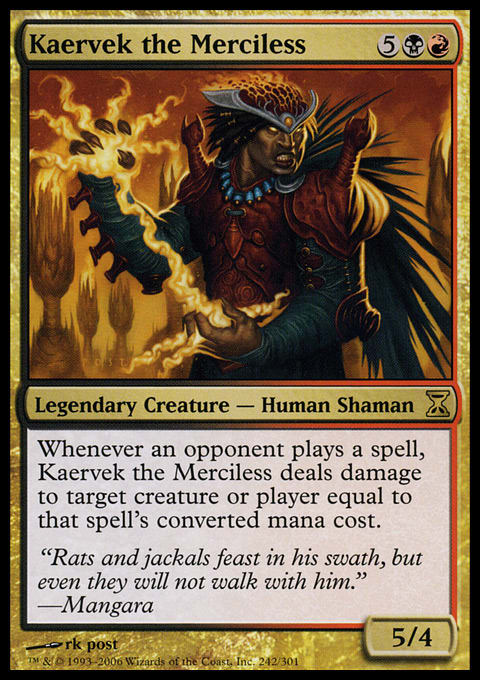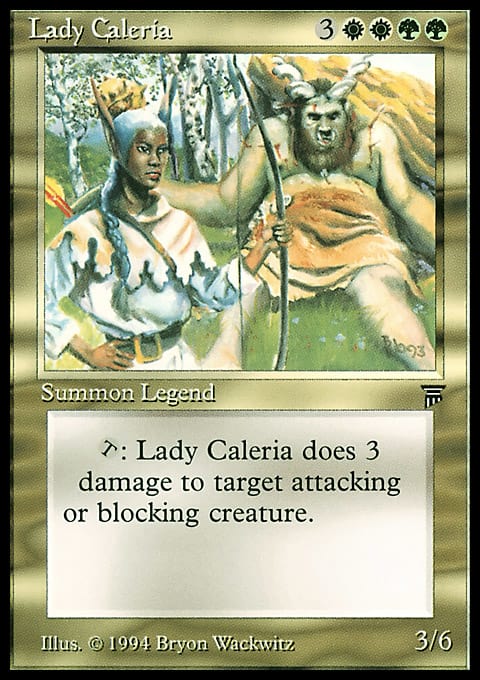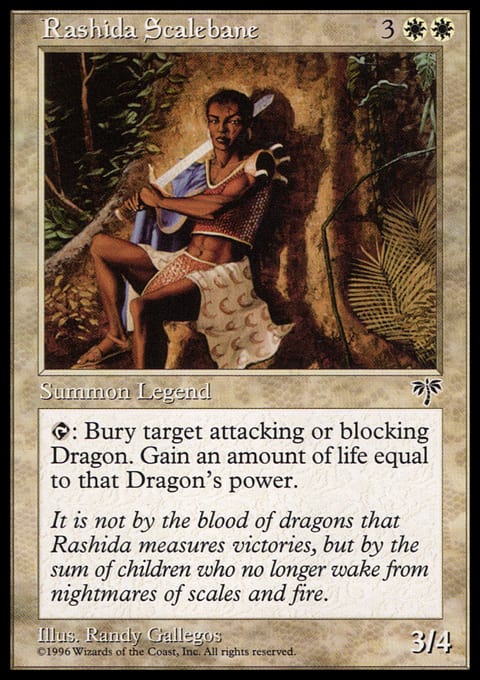February is Black History Month, and since I talk about art rather often in my little column here, I figured I’d look at how Magic has interacted, briefly, with black representation since 1993. I think I can easily say, without reference, that Mirage is fairly well-known to enfranchised players as the height of showing black characters in Magic. It was a set heavily influenced and guided by African themes, and since the set was created in 1996, we haven’t had a black group or tribe of humans really until this year with one of Theros’s three main cities or “poleis” with Setessa. While Magic encourages a wide variety of physical and racial depictions of humans, there are some parameters that artists have had to work within, such as “tan humans on Mirrodin” or the entire Kamigawa block.
I fought with myself on how to properly look at race in Magic without listing hundreds of cards and diluting any ability to analyze. I chose the champions of Magic to see the tip of the iceberg, and I think having legendary creatures, major storyline characters, and Planeswalkers are the key.
Of the 537 legendary creatures in Magic, 194 of them are Human. Of those 194 people, thirteen of them are black, hitting about 6.7% of the total. Of the 43 unique Planeswalkers, there are 29 humans, but really only 12 unique ones, and only one, Koth of the Hammer, is black. While Koth was reprinted in a Duel Decks bearing his name, Duel Decks: Venser vs. Koth, some efforts there could be made. Planeswalkers in general need considerably more representation. Perhaps the From the Vault: Legends set was a way to make a stride in representation. The set has fifteen legendary creatures, and there are black Humans, including Captain Sisay and Teferi, with Rafiq and Kresh being arguable diverse Human inclusions as well.
I’m happy to say that Wizards understands the lack of diversity in their Human depictions, and seeing Setessa in Theros is a great notion. Players want more diversity in race and gender. Read any MTG hash tag on Tumblr, and you’ll see a myriad of requests for a greater variety of everything! I’m all for it. I think it’s healthy, and frankly, even considering that “white men play this game and need to see themselves” is a tired belief that I don’t feel is held internally as Wizards. The brand team for sure hears the digital responses from the player base. I’d love to see an Arcana in the future comment on it. Maybe we’ll see something every February. It’d be a nice touch.
As for the thirteen black legendary Humans in Magic, let’s check them out!
Agrus Kos, Wojek Veteran by Donato Giancola, Ravnica: City of Guilds
Agrus Kos was the major character in the first Ravnica novels. He started as just a mere Wojek, a city guard or police officer of sorts, for Ravnica, and he had all sorts of shenanigans in the story, from becoming a ghost to possession to, well, continuing on. Having Donato depict him is just gravy. Donato is one of Magic’s best artists, and that’s a claim without hyperbole.
Alexi, Zephyr Mage by Mark Zug, Prophecy
Alexi also makes an appearance in Rhystic Study, and her gear appeared in in Alexi's Cloak. She was a major player in the storyline.
Alexi aided the forces of Barrin and Teferi against the Keldons in the Prophecy novel. Her dialogue isn’t the best in the book, but she’s present and an interesting character.
Anthousa, Setessan Hero by Howard Lyon, Theros
Anthousa is the head of the Setessa city-state and also one of the stars of the Theros intro pack bearing her name: Anthousa’s Army. Not much else is known on her or how she interacts with the gods yet.
Asmira, Holy Avenger by Rebecca Guay, Mirage
Asmira was the head of Femeref, and she has an amazing backstory that was woven through the entire Mirage storyline. She was a prophet and was the catalyst to free Mangara, who was imprisoned.
Captain Sisay by Ray Lago, Invasion
Sisay was also in many cards—Abduction, Volrath's Shapeshifter, Dehydration, and more. She also had her own Vanguard card. The Weatherlight Saga began with her, as she started to collect all the pieces of the Legacy, which were affected by Urza himself in his Bloodline project. If that sounds cool to you, you need to read the Artifacts Cycle of novels. They’re super-cheap and actually well-written compared to many of the other Magic novels.
Oddly, most people think of Gerrard as the “head” of The Weatherlight, but Sisay was the captain. Gerrard was the main antagonist, not the head of the whole thang. Just saying.
Crovax the Cursed by Pete Venters, Stronghold, and Crovax, Ascendant Hero by Pete Venters, Planar Chaos
Crovax was in a lot of cards as The Weatherlight Saga spanned many sets—cards such as Ascendant Evincar, Death Stroke, Massacre, and Whispers of the Muse, and he had a Vanguard card as well.
He was also one of the more complex characters we have seen in Magic’s history. In short, he was on The Weatherlight crew, loved an angel that couldn’t reciprocate, was manipulated by Phyrexians, killed Mirri, and became a vampire and crazy-evil. He led Phyrexian armies of Rath against Dominaria. Gerrard eventually killed him, and in an alternate reality, Mirri became cursed, not Crovax, and he became a champion of good. Read here for more on Crovax.
Ephara, God of the Polis by Eric Deschamps, Born of the Gods
I’m happy to say that Alexander Silady was quick to the punch in writing about Ephara on Examiner.
Ephara is basically the Athena of the Theros gods, giving a card-draw ability, tied to wisdom perhaps, to players. The official Uncharted Realms article states that she protects Meletis from the wild and people show worship by including her in architecture. Her face is included, which is reminiscent of many Latin American depictions of gods, instead of inclusions like many Greek gods. I think there’s still much to tell about this “minor” god of Theros, and we can hope to get more backstory on how she ascended.
Jolrael, Empress of Beasts by Matthew D. Wilson, Prophecy
Jolrael, or Jolreal, is the figure depiction in Spirit Link by Kaja Foglio, a major marketing image in the mid to late 1990s. She was another of the major characters of the Mirage storyline. She was a green mage whom met Teferi, she started a war with Kaervek, she realized Kaervek’s ambitions and deceptions, and she turned on him and defeated him.
Kaervek the Merciless by RK Post, Time Spiral
Kaervek wasn’t the nicest guy. He was the antagonist in the entire Mirage Wars. He allied with Jolrael to wage war, trying to gain power, but he was eventually defeated by a host of the good guys. Realizing that many of these legends were really all overlapping in the same story is quite notable. There hasn’t been a return to Dominaria, the home plane of Magic: The Gathering since the Time Spiral cycle, ending in 2007.
Lady Caleria by Bryon Wackwitz, Legends
This card is all kinds of odd. It was probably a Dungeons and Dragons character name, as many of the legends were from Wizards employees in 1994.
Lady Caleria is depicted as an elf, as her ears are enormous, though she’s a Human, even according to the errata. It makes sense from her ability that she is an Elf, but in the novels, she is actually mentioned twice, once in each of the Legends novels, due to miscommunication between writers. Once writers get assignments, they have had general guidelines, but the writer fills in other areas. This wasn’t the only example of this happening, but the fact is that she’s still subtyped as a Human.
Rashida Scalebane by Randy Gallegos, Visions
Randy is very aware of representation imagery in games. His Grizzled Outcasts / Krallenhorde Wantons has the most diversity of any card, off the top of my head, and it includes putzglas, a historically-accurate depiction of how preindustrial Germany created glass windows. Glass was blown on a stick, swirled, and then made flat. Where the rod was removed that held the glass, a nipple of sorts was left over. When monks used to clean church windows, that small leftover piece of glass made the window look ever-dirty. The German word for clean is putzen, and therefore, it is putzglas.
As for Rashida, she was the military presence compared to the mystical aid of Asmira. Her ability of killing dragons was actually changed in the errata to prevent even regeneration of the Dragons! It’s just an absurdly flavorful and powerful ability. In the storyline, she actually had the heads of the killed dragons brought with her army. Neat stuff. She was with Asmira to free Mangara. Dive into the novels or the MTGSalvation wiki to learn more. I’ve hyperlinked to their profiles.
Teferi, Mage of Zhalfir by D. Alexander Gregory and Jeremy Jarvis, Time Spiral, and Teferi, Mage of Zhalfir by Volkan Baga, From the Vault: Legends
Teferi studied at the Tolarian Academy—you know, the broken land that taps for blue with each artifact in play. He was a very powerful mage that sparked the Mirage Wars, spanning the Mirage and Visions sets of Magic. He also was part of the Phyrexian Invasion, spanning the Invasion Block by saving areas of Dominaria from being destroyed, and from doing so, he opened time rifts that spanned the Time Spiral Block. He was also a Planeswalker and sacrificed his spark to close the time rifts and save all the things.
If Teferi were around today, he would be similar to Jace Beleren in terms of in-game reference, power, and influence on the game. He was the third major character, really, in Magic’s history, following Urza and then Gerrard.
We can hope to see more diversity in Magic soon. Thanks for reading, and taking a look at our black legends. Happy February, and look at your cards more in the future. Check out whom exactly is shown, especially in depictions.
- Mike
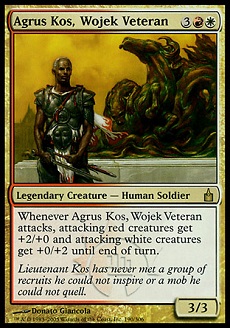 | 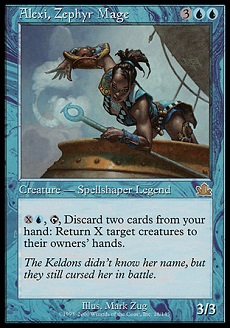 | 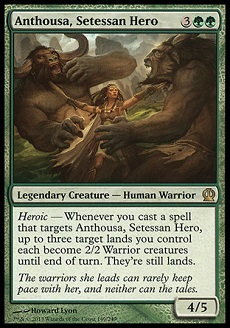 |
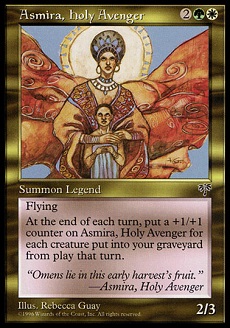 | 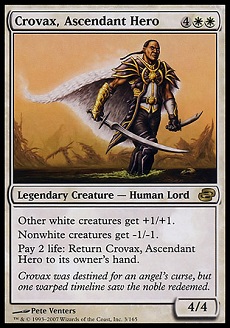 | 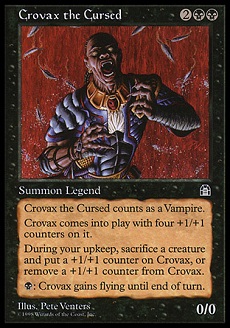 |
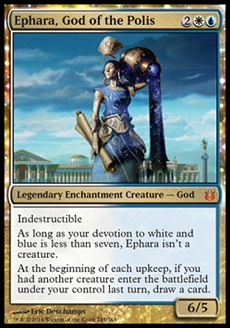 | 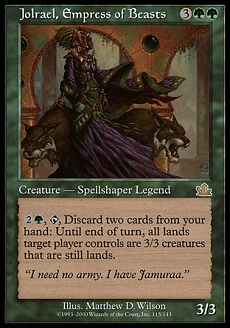 | 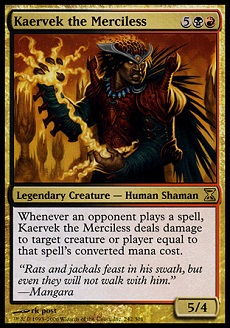 |
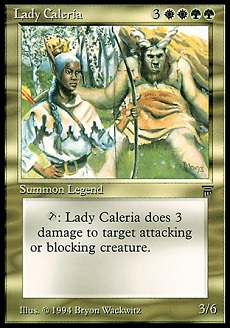 | 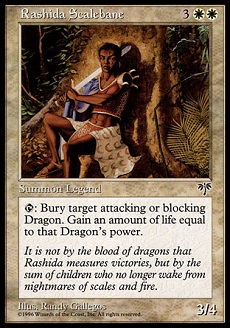 | 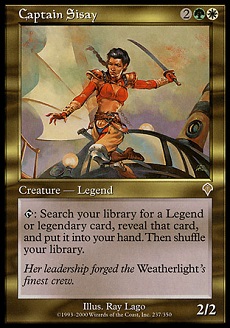 |
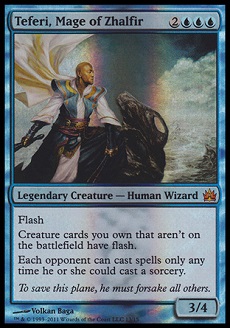 | 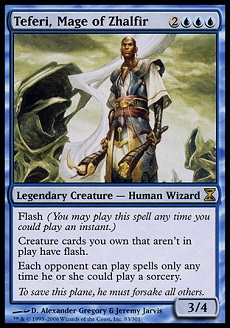 |
















